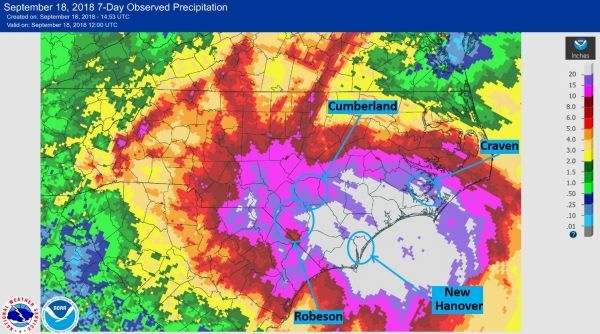As anticipated, Hurricane Florence resulting in monumental rainfall totals, particularly across southern and eastern North Carolina. This past week’s rainfall totals are depicted in Figure 1, derived from the NOAA/National Weather Service Advanced Hydrologic Prediction Service (AHPS). Widespread totals exceeded 10” across most of southern/eastern North Carolina and far eastern South Carolina, with maximum rainfall of more than 20” along and within a few counties of the Atlantic Coast.
The extreme rainfall dramatically impacted the soil moisture, which underwent a substantial transformation from very dry to near-saturation across south-eastern North Carolina. Figure 2 shows soil moisture retrievals before and after Hurricane Florence from NASA’s Soil Moisture Active Passive (SMAP) mission, which estimates near-surface soil moisture (~top 5 cm) in near-real-time derived from passive microwave satellite observations. A 6-day animation of hourly SPoRT-LIS simulated 0-100 cm relative soil moisture images overlaid with Multi-Radar Multi-Sensor rainfall contours (Fig. 3) nicely shows how the predominantly very dry soils across North and South Carolina prior to Florence were quickly moistened to near saturation over just a few days. [Ongoing research at SPoRT seeks to further improve the experimental soil moisture estimates by assimilating SMAP retrievals into the SPoRT-LIS framework.]
Read more at NASA
Image: Weekly total rainfall (inches), valid 11-18 September 2018, from the National Weather Service Advanced Hydrologic Prediction Service (AHPS) product. Four counties are denoted, for which soil moisture histogram animations are shown later in this article. CREDIT: NOAA


